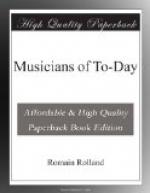The boats put hurriedly back to land, and one of them seems likely to be dashed to pieces on the shore. The whole village turns out to watch the disaster; but the men refuse to risk their lives in aid of the shipwrecked crew. Then the Stranger gets into a boat, and Vita jumps in after him. The squall redoubles in violence. A wave of enormous height breaks on the jetty, flooding the scene with a dazzling green light. The crowd recoil in fear. There is a silence; and an old fisherman takes off his woollen cap and intones the De Profundis. The villagers take up the chant....
One may see by this short account what a heterogeneous work it is. Two or three quite different worlds are brought into it: the realism of the bourgeois characters of Vita’s mother and lover is mixed up with symbolisms of Christianity, represented by the Stranger, and with the fairy-tale of the magic emerald and the voices of the ocean. This complexity, which is evident enough in the poem, is even more evident in the music, where a union of different arts and different ideas is attempted. We get the art of the folk-song, religious art, the art of Wagner, the art of Franck, as well as a note of familiar realism (which is something akin to the Italian opera-bouffe) and descriptions of sensation that are quite personal. As there are only two short acts, the rapidity of the action only serves to accentuate this impression. The changes are very abrupt: we are hurried from a world of human beings to a world of abstract ideas, and then taken from an atmosphere of religion to a land of fairies. The work is, however, clear enough from a musical point of view. The more complex the elements that M. d’Indy gathers round him the more anxious he is to bring them into harmony. It is a difficult task, and is only possible when the different elements are reduced to their simplest expression and brought down to their fundamental qualities—thus depriving them of the spice of their individuality. M. d’Indy puts different styles and ideas on the anvil, and then forges them vigorously. It is natural that here and there we should see the mark of the hammer, the imprint of his determination; but it is only by his determination that he welded the work into a solid whole.
Perhaps it is determination that brings unity now and then into M. d’Indy’s spirit. With reference to this, I will dwell upon one point only, since it is curious, and seems to me to be of general artistic interest. M. d’Indy writes his own poems for his “actions musicales”—Wagner’s example, it seems, has been catching. We have seen how the harmony of a work may suffer through the dual gifts of its author; though he may have thought to perfect his composition by writing both words and music. But an artist’s poetical and musical gifts are not necessarily of the same order. A man has not always the same kind of talent in other arts that he has in the art which he has made his own—I




